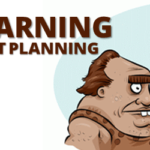[…] Traduzione autorizzata tratta dal post originale di Tom Kuhlmann sul “Rapid E-Learning Blog”. Il post originale è disponibile qui. […]
How Good Graphic Design Helps Build Meaningful E-Learning
July 5th, 2011
Because of my job, I look at quite a few elearning courses. One thing common to many of them is that they lack graphic design structure. This makes sense on a few fronts.
First, most of the people I talk to don’t have a graphic design background. So they tend to do very basic design work, if any at all. In addition, even if they wanted to do more, most don’t have a budget to hire a graphic designer or buy the appropriate graphics. On top of all of that, applications like PowerPoint provide a lot of free graphics and templates and it’s easy to rely on those for the design part of the course.
While these limitations are legitimate and present some obvious challenges, there’s no reason why you can’t learn some basic graphic design concepts.

When building elearning courses, everything on your screen should be there because you intended it to be there. It’s not like you go to get a cup of coffee and come back to find a bunch of screen beans in your course having a party.
Getting Started
Here are some previous posts that may help you build the graphics you need. Also, there are plenty of books on graphic design to help you get started. I like these three:

- The Non-Designer’s Design Book. Simple and easy follow. Good examples.
- Design Elements: A Graphic Style Manual. Covers a lot about graphic design basics.
- Slide:ology. Not a lot of hands-on instruction; but offers a broad overview with some good ideas.
Most rapid elearning designers aren’t also going to be outstanding graphic designers. However, with some practice you can be a competent graphic designer. The books above can help move you in that direction.
Good Graphic Design Creates Meaning
The essence of graphic design is structuring the visual elements on the screen to contribute to the meaning of the content. Like I stated earlier, nothing on the screen should be there by accident. Instead everything should contribute to the meaning of the course’s content and objectives.
For example, some shapes convey meaning even if they don’t contain any significant content. Here’s a simple example. An arrow implies movement. We tend to start at the tail and move towards to point. Combined with context, the arrow graphic helps reinforce the content and makes it more memorable.

Recently someone sent me a file where the content on one of the screens was shaped like a pyramid. If you’re doing an elearning course on ancient Egypt, a pyramid on the screen makes sense. Other than that, a pyramid shape on the screen implies meaning and should be intentional.
Typically a pyramid implies a hierarchical structure, like layers that build on each other. Without any other context, a pyramid generally will tell you that the information is weighted based on its position in layers and that there’s usually some sort of interconnected sequential relationship.

That’s the power of the graphic design elements. You can use shapes and diagrams to contain meaning that doesn’t need to be explained. This helps the learner learn the content. You can also direct the learner’s eye around the screen based on the type of shape and its placement.
However, in the screen I was looking at the pyramid shape existed solely because that’s what the person wanted to put on the screen. Other than “it looked good” there was no reason to have a pyramid.
This is a good example of how to confuse the learner. The visual structure of the content implied a relationship and meaning that didn’t exist. In fact, the only reason I noticed it was because I assumed the content had a certain relationship based on the pyramid layout. However, when I advanced a few slides I was confused. So I went back and realized that there was no relationship between the information and how it was stacked in the pyramid.
In her book Slide:ology, Duarte does a great job detailing all sorts of abstract shapes and diagrams that imply some concept. Many of them are relevant to the types of information seen in elearning courses. It’s worth reviewing if you have the book.
The main point in all of this is that nothing on your screen is there by accident. How you organize content on the screen implies meaning whether it’s intended or not. Everything you place on it should contribute to meeting the course’s objectives.
So if you’re just getting started, invest some time in learning basic graphic design concepts. It will help as you build your elearning courses. Don’t worry about being a professional graphic designer. Just spend some time learning the basics and build from there. The worst thing that can happen is that you build courses where the graphic elements are more meaningful to the course’s content. And that’s not a bad place to be.
Events
- Everyday. Check out the weekly training webinars to learn more about Rise, Storyline, and instructional design.
Free E-Learning Resources
 |
 |
 |
|
Want to learn more? Check out these articles and free resources in the community. |
Here’s a great job board for e-learning, instructional design, and training jobs |
Participate in the weekly e-learning challenges to sharpen your skills |
 |
 |
 |
|
Get your free PowerPoint templates and free graphics & stock images. |
Lots of cool e-learning examples to check out and find inspiration. |
Getting Started? This e-learning 101 series and the free e-books will help. |
18 responses to “How Good Graphic Design Helps Build Meaningful E-Learning”
Leggi la traduzione (autorizzata) in italiano di questo post qui:
[…] See the original post here: How Good Graphic Design Helps Build Meaningful E-Learning » The Rapid eLearning Blog […]
Great article, Tom. I couldn’t agree more. Design and meaning are intertwined. And effective use of the principles of design, such as focal point, harmony, balance, unity and contrast not only make the eLearning experience more pleasing, they affect how the audience perceives, processes, and interprets the information. Great book recommendations too. I have them all 🙂
Best,
Connie
For a guy who still can’t match drapes and carpet, this kind of help is valuable. And the books you recommend will be purchased! One of my problems is that even when I do something that is artful, I am too insecure about it. Since I pretty much work on my own, I lack artful people to inspire me.
I depend quite a bit on this blog and the links, so keep up this good work!
Another important article, Tom. Our e-learning design team has gotten to the point where they are applying many of the principles you discuss here, and that are covered in those books. However, I am trying to get them to an “Ariticulate Guru Award-level” in the creation of their courses. Do you have any recommendations as to courses they can take (online or classroom), books to read, etc. that would provide specific instruction on ways to improve their courses to get to that level of output?
Thanks for the great overview and reminders about basic graphic design and about intention and meaning behind everything in an e-learning course. I also got such a good laugh from your suggestion that the screen beans might sneak onto a page of my course when I’m not looking! Not only was that a great teaching technique — forcing us to think from a different perspective — but it added a humorous touch to the first day back after the long holiday weekend. Thank you for that!
I think it’s also important to remember how your readers actually “read”. For example, in English-speaking parts of the world, we read from left-to-right (so the arrow in Tom’s example would work well). However, in countries where they read right-to-left, the arrow example may not work so well.
Great article, Tom; thanks!
Thank you so much Tom. I’m new to instructional design and I appreciate your insight on graphic design. My passion lays within the design aspect of it, but you hit the key problems on the nose; lack of adequate resources to borrow. I will review the books you’ve mentioned to further guide me on this journey. Also, I really liked the point you keep making “nothing should be there by accident”. This is really funny as I’ve seen some really elaborate presentations and found myself confused just as you mentioned by an poorly chosen graphic, i.e. happy faces to a clearly serious matter, or complex organizational charts that have an awkward flow. I strive to have meaningful graphics. Thanks. Monica
Nice article Tom! Question: How do you get that black Cartoon figure (On the laptop!)
I really enjoy your blog post. I totally agree to the power of visuals. You dont need great text or audio to communicate if you have a great visual.
Here is an interesting blog article which demonstrates this. Hope you like it. http://blog.commlabindia.com/elearning/audio-narration-in-elearning
Great article! Our ID team is lucky enough to have a graphic artist, but this article is justification for why we need him!
In working with others in the ID field, I’ve found that so many rely on what “looks right” to the subjective eye of the designer. With all the time and effort we put into writing objectives and designing the flow of instruction, it’s easy to foret to apply the same level of scrutiny in the graphic design.
Thanks for the reminder!
This is a great article…and even if you can’t afford or are waiting for your books to arrive in the mail…while waiting or deciding, I would highly recommend searching this entire site for amazing ideas and templates about everything graphic design!! Just from what I learned on this site, my graphic design and eLearning skills have improved 100% or more.
Thank you for this Post. I’m from Germany and searching for more Information about Graphic Design. eLearning seems to be the right Way.
Regards
Biene
[…] How Good Graphic Design Helps Build Meaningful E-Learning …Description : The Rapid E-Learning Blog – how good graphic design helps build meaningful e-. Because of my job, I look at quite a few elearning courses. One thing common to many of them is that they lack graphic design structure. …http://www.articulate.com/rapi .. […]










0
comments